|
|
|
Sort Order |
|
|
|
Items / Page
|
|
|
|
|
|
|
| Srl | Item |
| 1 |
ID:
139172
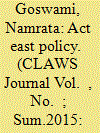

|
|
|
|
|
| Summary/Abstract |
For many years now, since 1992, when it laid its seed and slowly gathered momentum in policy circles, the “Look East” policy has been oft repeated in New Delhi’s strategic and policy circles as one of India’s foremost long-term policy visions to open up its economy for investment and trade with Southeast Asia. Increasingly now, the reference has changed from “Looking East” to “Acting East” by which one would expect that the policy is in its implementation phase. In augmenting the “Act East” policy, the northeast of India emerges, by the criterion of geography, as the region which will act as the ‘strategic catalyst’ or ‘game changer’ in accomplishing the vision that the policy aspires to embolden. Situated between China, Bhutan, Bangladesh, and Myanmar and with an international border stretching up to 4, 500 km, the region has held the promise of acting as a bridge between India and Southeast Asia for years. Its history vindicates such a role as its people have traded and travelled across the Southeast Asian region and Yunnan for years through the ancient Silk Road, trading in Himalayan salt, spices, handicrafts, food items, silk and other goods. This region witnessed migration of people from Southeast Asia and Yunnan to Assam and its surrounding hills, the most prominent being the Ahoms tracing their roots to the Tai race in Yunnan and Thailand. The Ahoms led by Sukapha arrived in Assam in
1228 A.D. and ruled over this region for 600 years. It is significant to note that the Ahoms under Lachit Borphukan successfully prevented Mughal expansion into Assam by defeating the Mughal Army in the much revered Battle of Saraighat of 1671.1
|
|
|
|
|
|
|
|
|
|
|
|
|
|
|
|
| 2 |
ID:
184390


|
|
|
|
|
| Summary/Abstract |
Systemic shift, in which the weight of the global economy has shifted away from the Euro-Atlantic eastwards, is increasingly underlined by what is referred to here as the ‘Asianisation of Asia'. Asianisation is a process in which Asia's diverse regions steadily converge around shared economic agendas. Japan, followed by the so-called ‘Asian Tigers’, were the pioneers of the Asian process, which began in earnest in the mid-1960s. China and India, drivers of the pre-modern world economy, are emulating the strategies of the early Asianisers this century and are building parallel pan-Asian relations of their own. Nowhere is this more evident, and indeed significant, than in relation to China and Iran, the Asianisers par excellence. Their relations are arguably critical to the process, a process which is infused with the legacy and their collective memories of the ancient Silk Road which had shaped pan-Asian relations for centuries before the rise of European power.
|
|
|
|
|
|
|
|
|
|
|
|
|
|
|
|
| 3 |
ID:
148688
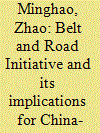

|
|
|
|
|
| Summary/Abstract |
The EU brought out a Global Strategy for foreign and security policy in June 2016, which indicates European efforts to reflect on and reshape its grand strategy. Meanwhile, China is also conducting an in-depth assessment of the international order under transition, and strives to rebalance its own national development and foreign policies. Beijing is pursuing a connectivity-oriented grand strategy. The peaceful rise of China depends on whether China and other economies can fully leverage each other’s development opportunities, and become stronger by taking advantage of increasing interconnectedness in the world. The One Belt, One Road (OBOR) initiative is a key element of such a grand strategy and will have far-reaching implications for China-Europe relations.
|
|
|
|
|
|
|
|
|
|
|
|
|
|
|
|
| 4 |
ID:
170851
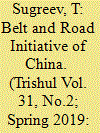

|
|
|
| 5 |
ID:
127340


|
|
|
| 6 |
ID:
145139
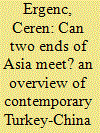

|
|
|
|
|
| Summary/Abstract |
China’s new Silk Road policy, titled “One Belt, One Road,” signals a proactive turn in China’s regional policy towards Central and West Asia. The policy has two dimensions: First, China aims to revitalize the old Silk Road exchange of goods, ideas, and people with trade, energy, and transportation projects. Second, armed with these new connections, China aims to redefine the territories the old Silk Road encompasses as a region in the contemporary international system. Turkey, as one of the countries at the westernmost end of the historic Silk Road, and one of the target countries of China’s new Silk Road diplomacy, welcomes the increasing economic and technological exchange with China. Establishing better contacts with China fits suitably in Turkey’s new foreign policy orientation. While the foreign policies of the two countries seem to be compatible, Turkish domestic political dynamics and public opinion hinder further engagement between the two ends of the Silk Road. The negative public opinion towards China manifests itself in the form of media coverage, protests and lobbying and, at times, it derails bilateral relations. This paper assesses the prospects for bilateral relations in the light of these developments. The paper starts with a historical analysis of Sino-Turkish relations and proceeds with various dimensions of the current relations. Then, it provides an analysis of various public opinion surveys in order to grasp the nature of the Turkish public opinion towards China, and it offers a media framing analysis in order to decipher the specific ways the image of China is constructed in Turkish public opinion. The last part of the paper discusses the domestic political actors that have a role in the perceptions and policies toward China in Turkey.
|
|
|
|
|
|
|
|
|
|
|
|
|
|
|
|
| 7 |
ID:
142091
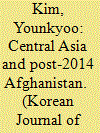

|
|
|
|
|
| Summary/Abstract |
As the NATO withdrawal proceeds in Afghanistan, both the Alliance and key members will encourage Central Asian states to assume more responsibility for providing their own security. But such a task is enormous for most Central Asian governments. Thus, they fear that they might be abandoned to Moscow, if not Beijing, or left on their own to face what they believe to be a mounting terrorist threat. This article examines the already visible military and strategic rivalry between Moscow and Washington for hegemony in Central Asia—mainly through support for weapon transfers, basing rights, and regional integration mechanisms in the security field.
|
|
|
|
|
|
|
|
|
|
|
|
|
|
|
|
| 8 |
ID:
128117
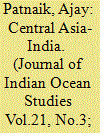

|
|
|
|
|
| Publication |
2013.
|
| Summary/Abstract |
Revival of the 'Silk Road' or Silk Road Strategy is a fashionable terms now days, even in Indian academic circles. Of course the word has been used more extensively by American and Chinese scholars. This began with the US Silk Road Strategy act of 1999, which talked of transporting the Central Asian region's natural resources to the international market.
|
|
|
|
|
|
|
|
|
|
|
|
|
|
|
|
| 9 |
ID:
164106


|
|
|
| 10 |
ID:
135571
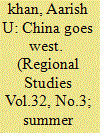

|
|
|
|
|
| Summary/Abstract |
While on a tour of the central Asian republics of Kazakhstan, Kyrgyzstan, Turkmenistan, and Uzbekistan in September 2013, Chinese president Xi Jinping made a historic speech at Nazarbayev University in Almaty. He gave a vision of the revival of the ancient Silk Routes from China through central Asia to turkey and other parts of Europe. The importance of the speech is amplified by fact that he gave a roadmap for the realization of his vision. While proposing an “economic belt along the silk Road”, he called for starting “work in individual areas and link them up over time to cover the whole region”.
|
|
|
|
|
|
|
|
|
|
|
|
|
|
|
|
| 11 |
ID:
138215
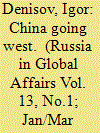

|
|
|
|
|
| Summary/Abstract |
Plans to create a Silk Road Economic Belt, which Chinese President Xi Jinping unveiled in a speech at the Nazarbayev University on September 7, 2013, at first sight looked nothing but a beautiful historical allusion, a nice figure of speech that had dawned upon official speech-writers or Foreign Ministry officials responsible for preparing Xi's trip to Central Asia.
|
|
|
|
|
|
|
|
|
|
|
|
|
|
|
|
| 12 |
ID:
160418
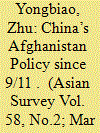

|
|
|
|
|
| Summary/Abstract |
Since 9/11, the relationship between China and Afghanistan has experienced four stages, which reflect China’s changing roles in this area. China is likely to play a greater role as it seeks to press ahead, despite obstacles, with its new Silk Road projects. In the future, China will likely be involved in Afghanistan in greater depth and on a larger scale.
|
|
|
|
|
|
|
|
|
|
|
|
|
|
|
|
| 13 |
ID:
138030
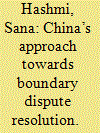

|
|
|
| 14 |
ID:
147977
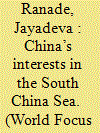

|
|
|
|
|
| Summary/Abstract |
Dominance of the South China Sea is not merely a territorial issue for China but, more importantly, one which it regards as a major step towards recognition as an unrivalled Asia-Pacific power that can arbitrate on global and regional issues along with the US. Since the 18th Congress of the Chinese Communist Party (CCP) and appointment of Xi Jinping simultaneously to China’s three top posts in November 2012, the world is witness to a new thrust to China’s already assertive foreign policy. Early in Xi Jinping’s term, China launched major, bold, geo-strategic initiatives aimed at expanding China’s diplomatic and economic influence and military power well beyond its frontiers.
|
|
|
|
|
|
|
|
|
|
|
|
|
|
|
|
| 15 |
ID:
147975
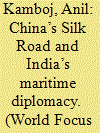

|
|
|
|
|
| Summary/Abstract |
The OBOR strategy has become China’s major foreign policy goal, Beijing will promote this initiative economically, politically, militarily and culturally over the next eight to ten years. For India, there are lessons from this. New Delhi also benefits from at least reasonable ties with most stakeholders in the New Silk Road, including Iran, where India has invested heavily in the Chabahar Port. But India must also make serious efforts to strengthen its links with Southeast Asia, and for this it must maintain stronger ties with Bangladesh. New Delhi will also need to work towards a manageable relationship with Pakistan, which would not only facilitate pipeline projects like TAPI, but also enable access to Afghanistan and Central Asia.
|
|
|
|
|
|
|
|
|
|
|
|
|
|
|
|
| 16 |
ID:
091845
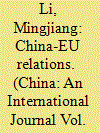

|
|
|
|
|
| Publication |
2009.
|
| Summary/Abstract |
China-EU relations, after more than a decade of steady growth since the mid-1990s, are becoming increasingly more fluid and unpredictable.Observers who had been optimistic are now starting to warn of an impending downward spiral in Sino-European ties.
|
|
|
|
|
|
|
|
|
|
|
|
|
|
|
|
| 17 |
ID:
139314
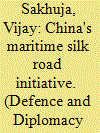

|
|
|
| 18 |
ID:
149584
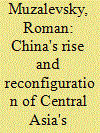

|
|
|
|
|
| Publication |
New Delhi, Alpha Editions, 2016.
|
| Description |
xiv, 116p.pbk
|
| Standard Number |
9789385505959
|
|
|
|
|
|
|
|
|
|
|
|
Copies: C:1/I:0,R:0,Q:0
Circulation
| Accession# | Call# | Current Location | Status | Policy | Location |
| 058922 | 327.151058/MUZ 058922 | Main | On Shelf | General | |
|
|
|
|
| 19 |
ID:
142946
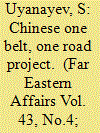

|
|
|
|
|
| Summary/Abstract |
This article examines the geographical boundaries, fundamental goals, principles, and ways of implementing the Chinese initative of the silk road economic belt.
|
|
|
|
|
|
|
|
|
|
|
|
|
|
|
|
| 20 |
ID:
173954


|
|
|
|
|
| Summary/Abstract |
This article analyzes discursive strategies of China and Japan to integrate newly emerging Central Asian (CA) states into their internal and external policies, norms and concepts, according to which they justify both their actions in CA and CA responses to these policies. This article elaborates the concept that to a certain extent, the interests of China and Japan in CA are similarly focused on mineral resources and political stability. However, these countries employ different discursive strategies to frame their approaches and goals. This article also emphasizes that the discourse of competition for regional domination prevalent in the English language, Russian and some CA media is largely an imposition of a zero-sum vision of international relations that is not proven by any empirical evidence. On the contrary, many of the projects conducted both by China and Japan are compatible – if not supplementary – and do not necessarily imply exclusivity of interest. At the same time, both China and Japan have different ways of reasoning their CA engagements, resulting in a rivalry of discourses for the ‘hearts and minds’ of the CA population.
|
|
|
|
|
|
|
|
|
|
|
|
|
|
|
|
|
|
|
|
|